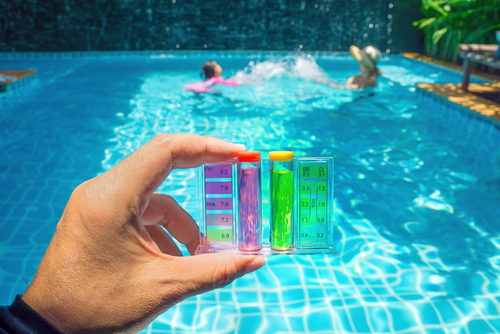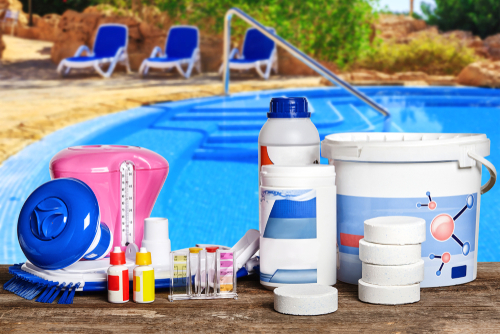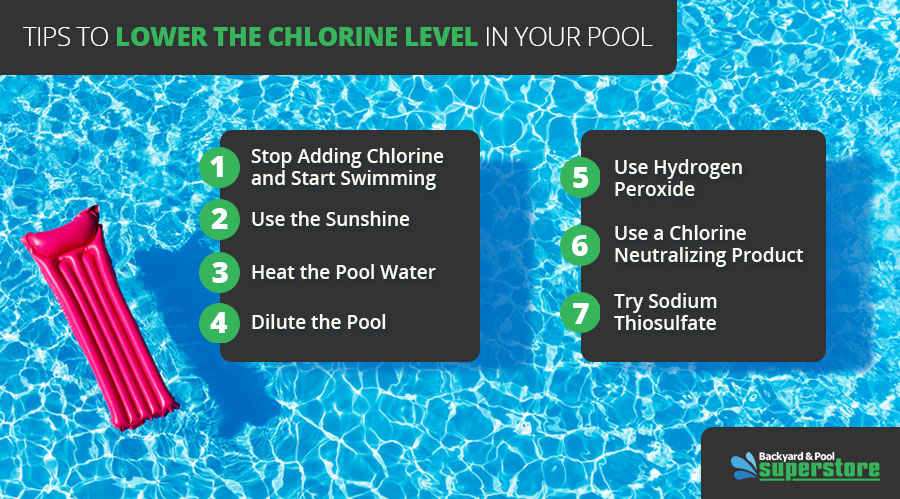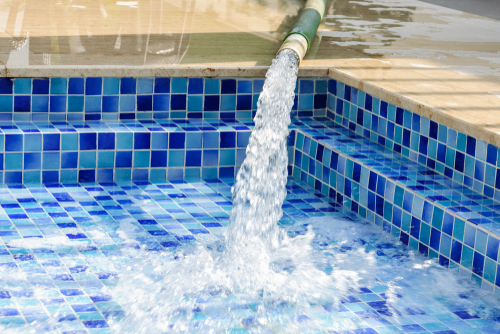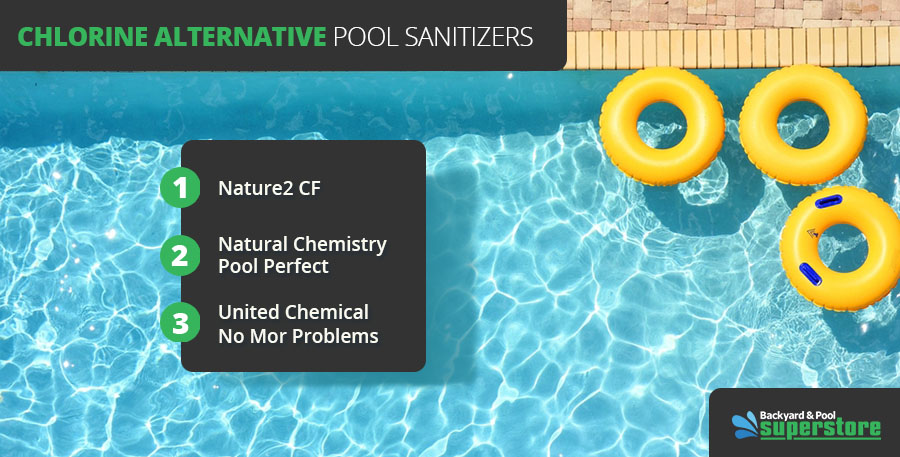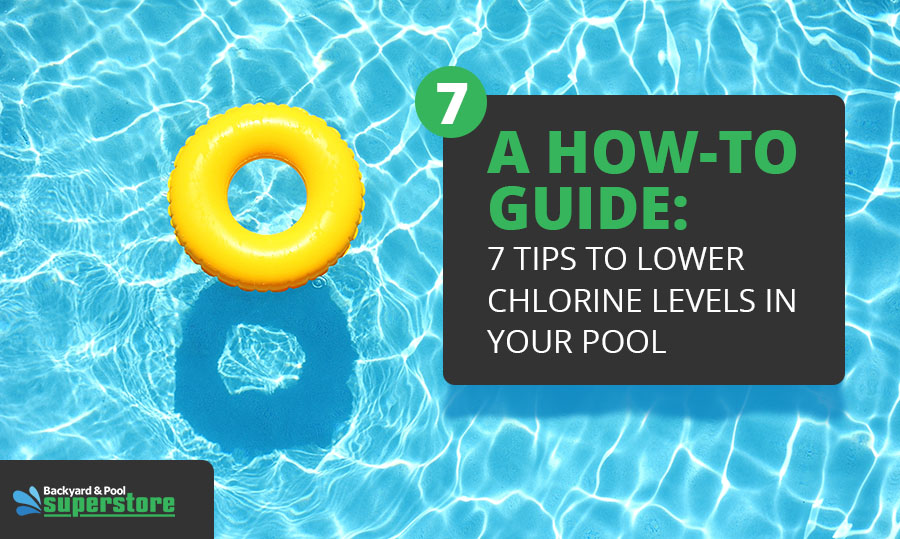
Chlorine is an integral part of maintaining a hygienic pool environment and proper pool chemistry. It can be challenging to balance your pool’s chemistry, and there is such a thing as “too much chlorine.” Fortunately, too much chlorine in your pool can be easily corrected. Read on to learn more about why the correct chlorine level is vital for your health and safety and how to lower the chlorine in your pool quickly and easily.
Why Is the Chlorine Level in my Pool Too High?
An over-chlorinated pool is a common issue for pools. Most manufacturers recommend shocking the pool when you open your pool each season. Shocking the pool means adding extra chlorine to the water to eliminate excess bacteria, algae and other microorganisms from your pool.
If you miscalculate and add more tablets or granules than necessary during the shocking process, or during routine maintenance, this can cause a high chlorine level. An over-chlorinated pool can have several adverse health implications.
Risks of Over-Chlorination
While slightly higher-than-normal levels of chlorine in your pool are harmless, exposure to an over-chlorinated pool can have adverse effects on your health and well-being. Excess chlorine can alter the pH level of the water in the pool, making it more acidic. The acid levels can cause any of the following symptoms:
Irritant dermatitis which is a red skin rash characterized by raised itchy red bumps
Eye irritation and over-dilated blood vessels in the eyes
Asthma and respiratory illness due to excess chlorine vapor on the surface of the pool
Respiratory problems typically occur after prolonged exposure to over-chlorinated pools, which causes the respiratory tract to become sensitive to chlorine. Most of these symptoms clear up on their own without the need for treatment within a few days to a week.
Although extremely rare, extreme over-chlorination can also cause chlorine poisoning. The signs and symptoms of chlorine poisoning include:
Nausea and vomiting
A burning sensation in the throat
Dizziness
Wheezing and shallow breathing
Persistent coughing
Tightness or pain in the chest
If you or anyone else who has used your pool experience these symptoms, contact your health care practitioner immediately in case treatment is needed.
Extreme pH changes can also affect how the chlorine works in your pool. Chlorine works most efficiently in water with a neutral pH level between 7.4-7.6. If the pool is too alkaline, or more than a pH of 8.0, the efficiency is less than 20 percent. A pH that is too high or low can also damage pool equipment, landscaping features, clothing, towels and swimsuits. It is vital to add the correct amount of chlorine to your pool to maintain the right pH level. You can test the pH of your pool with a simple pH strip test.
If you’re continuing to struggle with balancing the alkaline and acid in your pH levels, lower your pH levels by adding sodium bisulfate or muriatic acid. To raise your pH levels, it can be as simple as adding seven to nine pounds of baking soda to your pool water. Pool suppliers provide large containers of baking soda for pool pH balancing.
How to Tell if Your Pool Has Too Much Chlorine
The chlorine in your pool is made up of two types of chlorine compounds. Free chlorine is the “good” type of chlorine that is still available to eliminate bacteria and microorganisms. Combined chlorine, also known as chloramines, is what happens after the chlorine has combined with organic matter (such as bacteria) and is responsible for the characteristic smell associated with chlorinated pools.
Contrary to popular belief, you cannot smell how much chlorine is in your pool. Dry hair, sensitive skin and irritated eyes are all indicators of an over-chlorinated pool, but there is a less inconvenient and safer way to find out whether your pool has too much chlorine.
A DPD testing kit measures free and combined chlorine levels to give a total chlorine count. You could also use an OTO kit, but this only measures the free chlorine available in your pool. These types of titration tests are the most accurate method for determining the chlorine levels in your pool and help you better assess how to lower the chlorine levels in your pool if necessary.
To use the DPD testing kit, measure out a small amount of pool water and add buffered DPD powder to the water, which turns pink. Next, add a specialized FAS compound one drop at a time until the water transforms from pink to clear. Each drop of FAS compound is equivalent to 0.2 ppm of chlorine.
The CDC recommends that the ideal chlorine level for your residential pool is between one and three ppm. If the DPD testing kit indicates the chlorine levels of your pool are higher than normal, there are several ways to lower it.
Tips to Lower the Chlorine Level in Your Pool
The method you use to lower the chlorine levels in your pool depends on the concentration of the chlorine.
1. Stop Adding Chlorine and Start Swimming
For chlorine measurements only slightly higher than the recommended chlorine concentration, lowering chlorine levels in your pool can be as easy as not adding chlorine to your pool.
Switch off your chlorine feeder, remove the chlorine floater from the pool or remove chlorine tablets from the skimmer. Abating the continual influx of chlorine into your pool allows the chlorine currently in the pool to get used. Swimming in the pool can help speed up this process as the chlorine works to eliminate the bacteria introduced by the swimmers.
2. Use the Sunshine
A quick and easy way to dissipate chlorine in your pool is to take advantage of a warm, sunny day. Uncovering your pool and exposing the water to direct sunlight for at least two hours can reduce pool chlorine levels by up to 90 percent. The UV rays react with free chlorine to create chlorine gas, which is released into the atmosphere.
To try this method, stop chlorinating your pool and continue to monitor the chlorine levels to ensure they don’t drop below 2 ppm. Once they reach this level, resume regular chlorination to sanitize your pool.
If you use cyanuric acid in your pool, this method may be less effective. Cyanuric acid is used as a chlorine stabilizer to help the chlorine in your pool last longer.
3. Heat the Pool Water
Temperature can indirectly affect the chlorine levels of the pool water. An increase in temperature causes bacteria to proliferate, which use more of the chlorine.
If you have a heated pool, consider raising the temperature of the pool water to 90°F–10°F above the recommended level–for a short period. Continue to monitor chlorine levels throughout the day.
4. Dilute the Pool
To dilute your pool water, partially drain the pool and then top it up with fresh water. This method has several disadvantages compared with other chlorine lowering tips.
Draining and refilling your pool takes a lot of time. Reduce the amount of time it takes to drain the pool by backwashing if you have sand or DE filters. Diluting the pool water can also significantly increase your water bills, depending on the municipal water rates in your area.
It also disrupts the pH level and water hardness of your pool, which you will need to monitor and carefully readjust after you finish diluting the pool.
This method can be a good option for pool owners who also need to deal with a blocked sand filter, an increased total dissolved solids level or excess copper or cyanuric acid.
5. Use Hydrogen Peroxide
Hydrogen peroxide is a powerful oxidizer and reacts with chlorine to produce water and oxygen. It is working if you notice small, effervescent bubbles in the pool.
For the best results, use hydrogen peroxide that is formulated for pools. This product has a higher concentration of hydrogen peroxide than products used for cleaning your home.
Hydrogen peroxide works most effectively at pH levels higher than 7.0. Before using this product, test the pH of the pool and adjust the levels to ensure that the hydrogen peroxide eliminates excess chlorine effectively.
6. Use a Chlorine Neutralizing Product
There are many chlorine neutralizing products available on the market that are specially formulated to reduce the amount of chlorine in your pool without disrupting the pH, alkalinity or water hardness levels. Add the neutralizer gradually to avoid removing too much chlorine and needing to readjust the levels again.
Depending on the level of chlorine present in your pool, you may need to use multiple treatments to return the pool to a safe level for swimming.
7. Try Sodium Thiosulfate
Sodium thiosulfate is an affordable alternative to pre-formulated chlorine neutralizing products. The amount you need to add depends on the number of gallons of water in your pool and the initial chlorine level.
The best way to add sodium thiosulfate to the pool is with a pool skimmer. As sodium thiosulfate remains in the water until it has reacted with all the chlorine available, it is easy to overshoot the mark and remove too much chlorine. Begin by adding half the recommended amount per the manufacturer’s instructions. Then, test the chlorine levels again before adding more.
Test the pH of the pool after treatment with sodium thiosulfate. The chemical reaction with the chlorine and water lowers the overall pH of the pool, which can make it too acidic.
For pools sanitized with stabilized chlorine, remember that if you use a chemical method to neutralize the chlorine in your pool, the cyanuric acid level will stay the same. When you add stabilized chlorine back into the pool to resume sanitizing the pool, this increases the cyanuric acid level further and alters the pH level of the water. Carefully monitor the level of cyanuric acid and the pH after finishing any neutralizing treatment.
Alternative Pool Sanitizers
If you have sensitive skin or do not like using chlorine in your pool, there are several alternativepool sanitizerproducts available to prevent bacteria and algae from building up in your pool. These alternative sanitizing products allow you to significantly reduce the amount of chlorine you use in your pool and reduce the risk of over-chlorination.
Nature2 CF
Nature2 CF is a mineral sanitizer that uses minerals, typically silver and copper, to react with the pool water to release positive ions. These positive ions destroy negatively charged organic matter such as bacteria, body oils and algae.
The Nature2 CF cartridge works with your pool’s existing filtration system and features controlled release technology to optimize mineral levels in your pool. This product not only helps to sanitize your pool, but it can also improve the feel of the water.
Natural Chemistry Pool Perfect
Natural Chemistry Pool Perfect is a great way to complement chlorine sanitation by using enzymes to break down organic matter in the pool water, which allows it to dissipate more efficiently. Pool Perfect also contains compounds to reduce the phosphate levels in your pool that can increase the risk of algae growth.
United Chemical No Mor Problems
No Mor Problems is designed to work synergistically with the chlorine in your pool. The special formulation breaks up chloramines and reduces the need to add extra chlorine back into the pool. It also works to clarify your pool water and unclog filters to speed up filtration times. No Mor Problems is also an algaecide, which means that it eliminates algae and prevents regrowth. Best of all, it is completely biodegradable and non-toxic, so it is safe for your family.
Final Thoughts
Keeping your pool chemistry within the right limits provides a more enjoyable swimming experience and a longer-lasting pool. If you happen to over-chlorinate your pool, there are many simple ways to neutralize the chlorine and prevent any negative health effects.
To learn more about pool and spa sanitizers, and how to keep your pool clean and hygienic, call us at 800-926-5770 to speak with our experienced staff about the sanitizing products we have available.
 Hello Guest,
Hello Guest,  0 item(s)
0 item(s)
